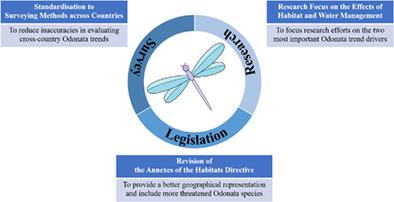当前位置:
X-MOL 学术
›
Insect Conserv. Divers.
›
论文详情
Our official English website, www.x-mol.net, welcomes your
feedback! (Note: you will need to create a separate account there.)
Biases of Odonata in Habitats Directive: Trends, trend drivers, and conservation status of European threatened Odonata
Insect Conservation and Diversity ( IF 3.2 ) Pub Date : 2020-09-18 , DOI: 10.1111/icad.12450 Dorothy Hok Yau Tang 1 , Piero Visconti 1, 2
中文翻译:

人居指令中Odonata的偏见:欧洲受威胁的Odonata的趋势,趋势动因和保护状况
更新日期:2020-09-18
Insect Conservation and Diversity ( IF 3.2 ) Pub Date : 2020-09-18 , DOI: 10.1111/icad.12450 Dorothy Hok Yau Tang 1 , Piero Visconti 1, 2
Affiliation

|
- Dragonflies and damselflies, within the order of Odonata, are important ecological indicators with widely recognised conservation value. They are generally better researched and protected than other invertebrates, yet, they have received limited protection from the European Union (EU)'s Habitats Directive, which serves as the major legislative tool for species conservation in Europe.
- We reviewed the conservation status and trends, legal protection status, and knowledge gaps of Odonates within the EU. Among the 22 threatened and 27 endemic species in EU, respectively 19 and 11 of them are not protected by the Directive. Out of the 35 species which are threatened and/or listed on the Annexes, 61.5% of them are declining.
- Nevertheless, threatened non‐Annex species are more likely to have a decreasing population trend than Annex species. There are also 26% of threatened non‐Annex species with unknown trends. Inaccuracies in evaluating Odonata trends are also revealed due to the lack of standardised methodology and incomplete surveys.
- Moreover, most conservation research focuses on climate change's effects on range shift, therefore knowledge gaps exist in understating how water and habitat qualities, the most important Odonate trend drivers, shape Odonata conservation status.
- There is an urgent need to revise the legal protection status of Odonata in Europe, for instance by revising the EU Habitats Directive Annexes to include threatened damselflies and dragonflies.
- There is also an urgent need for systematic, standardised, and regular survey to be able to investigate trends and drivers of change to identify priority conservation actions.
中文翻译:

人居指令中Odonata的偏见:欧洲受威胁的Odonata的趋势,趋势动因和保护状况
- 在蜻蜓目中,蜻蜓和蜻蜓是重要的生态指标,具有广泛的保护价值。与其他无脊椎动物相比,它们通常得到更好的研究和保护,但是,它们受到欧盟(EU)人居指令的有限保护,该指令是欧洲物种保护的主要立法工具。
- 我们回顾了欧盟内Odonates的保护状态和趋势,法律保护状态以及知识差距。在欧盟的22种受威胁物种和27种特有物种中,分别有19和11种不受该指令的保护。在威胁和/或列入附件的35个物种中,有61.5%处于下降状态。
- 但是,受威胁的非附件物种比附件物种更容易减少种群趋势。还有26%受威胁的非附件物种具有未知趋势。由于缺乏标准化的方法和不完整的调查,在Odonata趋势评估中也发现了不准确之处。
- 此外,大多数保护研究都集中在气候变化对范围变化的影响上,因此,在低估水和生境质量(最重要的齿状齿趋势动因)如何影响齿形齿科保护状态方面存在知识空白。
- 迫切需要修改欧洲蜻蜓目(Odonata)的法律保护地位,例如,通过修订欧盟人居指令附件,以包括受威胁的豆娘和蜻蜓。
- 迫切需要进行系统的,标准化的和定期的调查,以便能够调查趋势和变化的动因,从而确定优先保护行动。











































 京公网安备 11010802027423号
京公网安备 11010802027423号